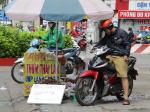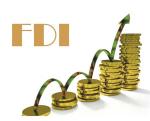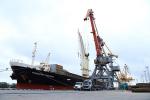Public investment sped up for economic recovery and development
ABO/NDO - Vietnam is making great efforts to speed up public investment with new and strong momentum, considered a sturdy foundation for the country to spur on economic growth.
The Politburo has enacted hallmark Conclusion No.77-KL/TW on overcoming the impacts of the COVID-19 pandemic for economic recovery and development.
One of the key highlights of the conclusion is the Politburo ordering the acceleration of public investment, improvements in the effectiveness of the use of public investment, with all kinks in administrative procedures to be removed, and speeding up procedures approving and revising new policies.
“It is necessary to commence and expedite large-scale projects that can have far-reaching impacts on the socio-economic development of localities, regions, and economic sectors,” the conclusion reads.
It is also necessary to further “strengthen discipline and enhance efficiency of state management, and responsibility. Responsibility of groups and individuals to ensure the speed of public investment disbursementmust also be clarified.”
Notably, the Poliburo underlined a number of a projects belonging to the Eastern Cluster of the North-South Expressway project for the 2017-2020 period from the public-private partnership (PPP) to public investment.
 |
| Expressways are to be developed with the massive state funding for higher economic growth. |
The National Assembly’s (NA) Standing Committee has also decided that three out of eight expressway projects, which are parts of the Eastern Cluster of the North-South Expressway project, will be funded with money from the state budget. These three projects arethe Mai Son-National Highway No.45 (63.4 kilometres), the Vinh Hao-Phan Thiet (106km), and the Phan Thiet-Dau Giay (98km). The state will invest an additional sum of more than VND23.46 trillion (over US$1 billion) into these projects.
Currently, this plan is under discussion by the whole legislature.
According to the NA Standing Committee, these three projects are of great importance and urgency for investment due to the rising demand for traffic. All of them were planned for investment under the PPP method.
For instance, the Phan Thiet-Dau Giay section running through the south-central province of Binh Thuan and the southern province of Dong Nai is to cost over VND14.36 trillion (US$624.35 million) for just the first stage. It has been assigned for investment under the build-operate-transfer (BOT) format, one of the PPPinvestment types.
Of the capital, state-funded capital is VND2.48 trillion (US$107.8 million) with the prime minister’s approval. The project is estimated to be completed within three years.
Meanwhile, the Mai Son-National Highway No. 45 section running through the northern province of Ninh Binh to the north-central province of Thanh Hoa has a total investment capital of more than VND12.9 trillion (US$560.87 million), including VND3.17 trillion (US$137.8 million) worth of government bonds withthe rest financed by investors. It is expected that this project will commence this year and come into operation next year.
In reality, investment into these projects is just part of the government plan to boost public investment amid low the economic growth caused by weak production and exports. In Resolution 84/NQ-CP released two weeks ago on tasks and solutions to remove enterprises’ difficulties, boost public investment, and ensure social order, Prime Minister Nguyen Xuan Phuc underlined a strong boost for public investment as one of the key measures to spur on economic growth, which was only 3.82% in the first quarter of 2020.
“Strong efforts must be made to disburse public investment, and this must be considered an important political task to stimulate production and business, and consumption, create jobs, and ensure social security,” the resolution stated. “It will also help attractinvestment from many other sources.”
The government will also “continue to review all regulations on budget and construction, and remove difficulties so as to speed up the effective disbursement of state-funded projects.”
According to the Ministry of Finance, total available public investment capital for 2020 is about VND700 trillion (US$30.4 billion), which is 2.2 times higher than VND312 trillion (US$13.56 billion) last year.
About VND31.1 trillion (US$1.35 billion) was disbursed in May, up 17.5% year-on-year. In the first five months, the figure was VND116.3 trillion (over US$5), up 15.6% year-on-year.
The disbursement rate of this type of capital in May and in the first five months of this year reached the highest levels of the same periods during 2016-2020.
The government ordered that the VND700 trillion (US$30.4 billion) must be disbursed completely within this year.
A few weeks back, Hanoi People’s Committee adopted a resolution on using VND34.64 trillion (US$150.6 million) to invest in constructing six large-scale flyovers in the inner city, within 2021-2022. The investment capital is from the municipal budget.
Hanoi People’s Committee has also decided to invest into another four transport and technical infrastructure projects, with total capital of VND713.3 billion (US$31 million).
In 2020, the city will use VND37-40 trillion (US$1.6-1.74 billion) for public investment. Under the 2016-2020 medium-term investment plan, it has VND107.3 trillion (US$4.66 billion).
From now until the year’s end, the city will also invest in boosting the construction of another five key projects, including the Vinh Tuy Bridge second phase; site clearance of an area 500 metres away from the Nam Son dumping ground; constructing a connection road of the Phap Van - Cau Gie expressway with ring-road No3; a project to build a concentrated wastewater treatment system for the city’s industrial clusters; and a project on site clearance in Nam Tu Liem district.
According to the General Statistics Office, the accelerated disbursement of public investment will spur on economic growth. If public investment increased 1%, it will help attract more private investment capital by 0.92%, and will enable GDP to climb by an additional 0.06 percentage points.
Over recent years, public investment capital has been too slowly disbursed because of various reasons, negatively affecting Vietnam’s socio-economic development. This capital creates 10.7% of the nation’s GDP and 32% of the total investment capital in 2019.
“If localities fail to disburse in full this capital in September, the government will ask permission from the NA to cut their capital and move it to other localities with more effective projects, while heads of ministries and the localities will be punished and inspections will be launched over their public investment activities,” PM Phuc stressed.
According to Resolution 84, in order for public investment to go smoothly, frequent inspections will be organised at related projects and plans.
“Strict punishment will be imposed on any organisations, individuals, leaders, cadres, and officers who violate the law and intentionally cause difficulties and delays to the speed of public investment disbursement and construction of projects,” the resolution stated.
(Source: NDO)
 về đầu trang
về đầu trang







